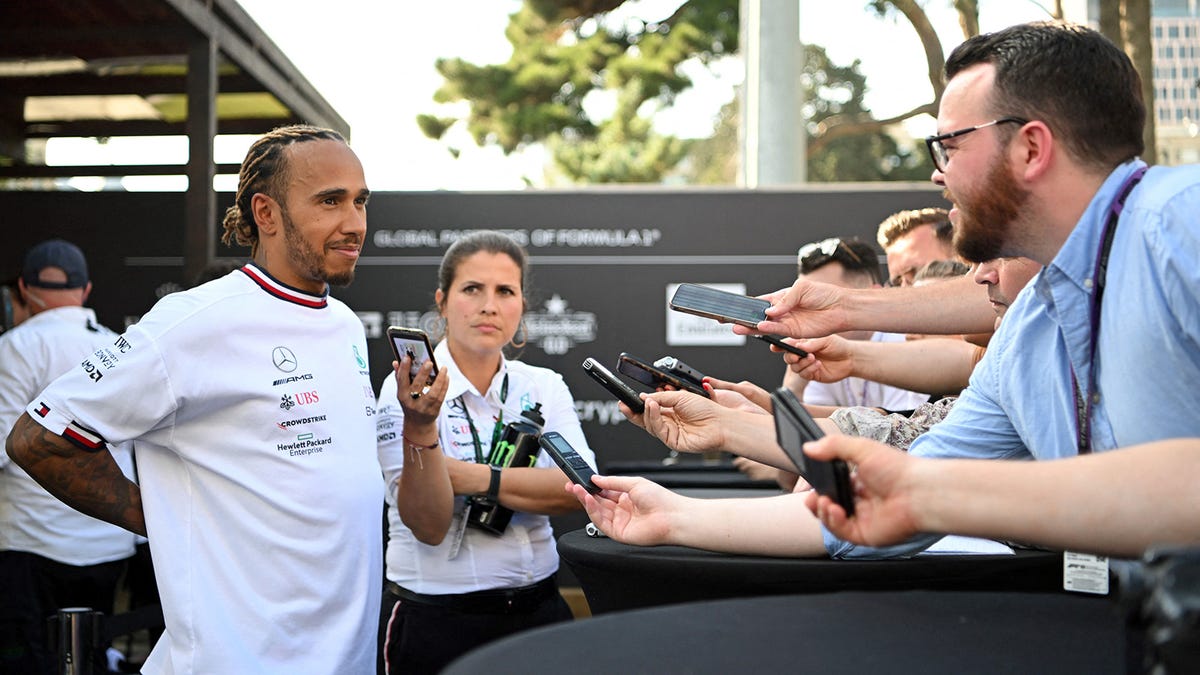Formula 1 Will Try to Tackle the Porpoising Problem

Photo: Natalia Kolesnikova/AFP (Getty Images)
Formula 1‘s new-for-2022 ground-effects chassis have exhibited a chronic bouncing issue, and some teams and drivers are experiencing it worse than others. Lewis Hamilton, seen above holding his lower back during a post-race interview in Baku, needed help getting out of his car following last Sunday’s event; Mercedes’ chief strategist James Vowles admitted after the fact that his crew went “too far” in deciding the aggressiveness of Hamilton’s setup. F1 has noticed this trend, and plans to do something about it.
On Thursday as teams were arriving in Montreal for this weekend’s Canadian Grand Prix, the FIA issued a statement, announcing that it will intervene “in the interests of the safety.”
Following the eighth round of this year’s FIA Formula One World Championship, during which the phenomenon of aerodynamic oscillations (“porpoising”) of the new generation of Formula 1 cars, and the effect of this during and after the race on the physical condition of the drivers was once again visible, the FIA, as the governing body of the sport, has decided that, in the interests of the safety, it is necessary to intervene to require that the teams make the necessary adjustments to reduce or to eliminate this phenomenon.
No rules are expected to be handed down for Sunday’s Grand Prix, per Crash.net, as the FIA is taking the next event to monitor the issue. This will ultimately result in the “definition of a metric” to assign a quantifiable value to porpoising, with the implication that a value too high will not be permitted to run. (We don’t know what this new measurement will be named as it hasn’t been created yet, but I see absolutely no reason why it can’t be dubbed “porpoises.”)
A Technical Directive has been issued to give guidance to the teams about the measures the FIA intends to take to tackle the problem. These include:
1. Closer scrutiny of the planks and skids, both in terms of their design and the observed wear
2. The definition of a metric, based on the car’s vertical acceleration, that will give a quantitative limit for acceptable level of vertical oscillations. The exact mathematical formula for this metric is still being analysed by the FIA, and the Formula 1 teams have been invited to contribute to this process.
In addition to these short-term measures, the FIA will convene a technical meeting with the Teams in order to define measures that will reduce the propensity of cars to exhibit such phenomena in the medium term.
Given Hamilton’s obvious discomfort and AlphaTauri’s Pierre Gasly fearing he’ll need a cane to walk by age 30 (that’s only four years away, buddy!), you might think the FIA is acting out of concern for drivers’ physical pain. That’s part of it, but it’s less the physical stress itself and more how the pain contributes to their attentiveness — or lack thereof — behind the wheel.
In a sport where the competitors are routinely driving at speeds in excess of 300km/h, it is considered that all of a driver’s concentration needs to be focused on that task and that excessive fatigue or pain experienced by a driver could have significant consequences should it result in a loss of concentration. In addition, the FIA has concerns in relation to the immediate physical impact on the health of the drivers, a number of whom have reported back pain following recent events.
Naturally, the prevailing conspiracy theory is that Mercedes, whose cars are suffering from porpoising more dramatically than, say, Red Bull’s, is lobbying for a rule change in a desperate hope that the FIA will curb the performance of teams that are less hampered by this phenomenon, thereby making the Silver Arrows cars more competitive. I’m sure somewhere in the corners of Merc team chief Toto Wolff’s mind, that idea must seem awfully attractive — but it’s also completely irrelevant. This is a safety issue. Plenty of drivers who don’t compete for Mercedes are complaining about it, and therefore something should be done.
While the FIA has not yet announced the protocol it intends to take here, rumors are already stirring from German publication Auto Motor und Sport, by way of PlanetF1. Supposedly, officials are favoring a mandatory 10 millimeter boost to ride height if floor oscillations are recorded beyond a certain threshold during Friday’s two practice sessions. This would theoretically make Mercedes even slower, since the team would be required to jack up Hamilton and George Russell’s cars to tamp down porpoising, negatively impacting pace.
For what it’s worth, Gasly himself believes that however the FIA chooses to go about this will have but a “minimal” impact to everyone’s relative performance. Team bosses seem to be considerably more skeptical of that on the whole, but then they’re not the ones whose butts are in the cars.



